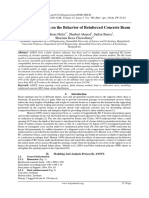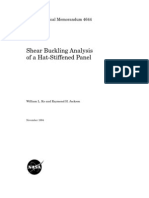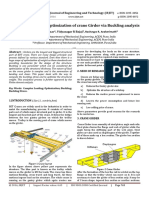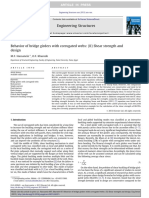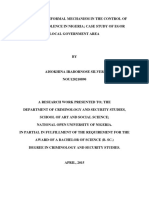0 ratings0% found this document useful (0 votes)
208 viewsStructural Damping Definitions
This document defines several common ways that damping in mechanical systems can be characterized:
1) Damping ratio compares the physical damping coefficient to the critical damping coefficient, providing a measure of how oscillatory the system response is.
2) Q factor is another interpretation of damping that is the rate of energy loss relative to stored energy in the system. It relates to damping ratio.
3) Dissipation factor is the reciprocal of Q factor and expresses damping as a percentage. Exponential attenuation and loss angle also characterize damping. Specific damping capacity divides energy dissipated by energy applied to a system.
Uploaded by
Louc IngCopyright
© © All Rights Reserved
Available Formats
Download as PDF, TXT or read online on Scribd
0 ratings0% found this document useful (0 votes)
208 viewsStructural Damping Definitions
This document defines several common ways that damping in mechanical systems can be characterized:
1) Damping ratio compares the physical damping coefficient to the critical damping coefficient, providing a measure of how oscillatory the system response is.
2) Q factor is another interpretation of damping that is the rate of energy loss relative to stored energy in the system. It relates to damping ratio.
3) Dissipation factor is the reciprocal of Q factor and expresses damping as a percentage. Exponential attenuation and loss angle also characterize damping. Specific damping capacity divides energy dissipated by energy applied to a system.
Uploaded by
Louc IngCopyright
© © All Rights Reserved
Available Formats
Download as PDF, TXT or read online on Scribd
You are on page 1/ 1
PRECISION POINT
Dynamics & Control STRUCTURAL DAMPING DEFINITIONS 1/1
Introduction Logarithmic decrement
Every part of a mechanical system, from actuator to end- Damping ratio can be retrieved from resonant time-response
effector, comprises damping. This sheet gives an overview of data by means of the logarithmic decrement , which can be
ways damping can be defined and how these definitions are calculated from the amplitude of peak responses:
related to the linear dimensionless damping coefficient .
What is damping? The damping ratio is calculated by:
Damping in mechanical systems is the extraction of
mechanical energy from the motion in the system, usually by ( )
conversion of potential energy into heat. Therefore it can be
regarded as a loss of energy. However, the positive effect of This method becomes inaccurate for large damping values,
damping is that it attenuates oscillations due to internal i.e. .
resonances. Damping is often modeled as a dissipation force
proportional to the velocity, , which is known as p(t0)
T
viscous damping. However the underlying principle is more
complex and nonlinear in nature. n
p(t0+nT)
t
t0
Damping ratio
A frequently used measure for damping in a system is the
damping ratio. It characterizes the damping in a linear
Dissipation factor
second-order system as the ratio of physical damping
The dissipation factor (DF), which is often expressed as a
coefficient , over the critical damping coefficient percentage, is the reciprocal of the Q factor:
with This corresponds with the level of
damping that the response becomes non-oscillatory. Note
that this is a linear definition of damping, for which a model Exponential attenuation / decay rate
of the underlying system is needed. Often called attenuation , is defined as [rad/s],
which represents the exponential decay of the oscillation.
Q factor
Another interpretation of damping is given by the quality or Loss angle
Q factor, which is more widely used in other fields of physics. By applying a harmonic load F to a system, the response
It is a measure for how under-damped the system is. It is can (deflection x), is known as the loss angle , which is a
be retrieved from frequency-response data: measure for damping. It relates to the damping ratio by
.
Specific damping capacity
A
By dividing the amount of energy dissipated in an
harmonically excitated structure divided by the work applied
to it, the specific damping capacity can be calculated:
2 A (-3 dB)
The interpretation of this measure can be clarified by means
of the hysteresis curve:
F
n
magnitude
frequency W = F x2
x
x
Another interpretation of Q is the rate of energy loss relative
to the stored energy in the resonating system: W
It relates to the damping ratio by .
www.jpe.nl
You might also like
- Matrix of Destiny Numerology Calculation Free From Kabala0% (1)Matrix of Destiny Numerology Calculation Free From Kabala1 page
- Modeling The Hysteretic Response of Mechanical Connections For Wood StructuresNo ratings yetModeling The Hysteretic Response of Mechanical Connections For Wood Structures11 pages
- FEM Analysis and Mxy Moments in Concrete DesignNo ratings yetFEM Analysis and Mxy Moments in Concrete Design4 pages
- A Material Model For Flexural Crack Simulation in Reinforced Concrete Elements Using AbaqusNo ratings yetA Material Model For Flexural Crack Simulation in Reinforced Concrete Elements Using Abaqus5 pages
- Bond-Slip Model For Detailed Finite-Element AnalysisNo ratings yetBond-Slip Model For Detailed Finite-Element Analysis10 pages
- On The Evaluation of Critical Lateral Torsional Buckling Loads of Monosymmetric Beam ColumnsNo ratings yetOn The Evaluation of Critical Lateral Torsional Buckling Loads of Monosymmetric Beam Columns8 pages
- Effect of Friction Pendulum Bearing Properties On Behaviour of BuildingsNo ratings yetEffect of Friction Pendulum Bearing Properties On Behaviour of Buildings20 pages
- Application of Friction Pendulum System To The Main Control Room of A Nuclear Power PlantNo ratings yetApplication of Friction Pendulum System To The Main Control Room of A Nuclear Power Plant10 pages
- Analysis of Structures On Elastic Foundation Incorporating The Spectral Method of Boundary Elements (Levon G. Petrosian) (Z-Library) PDFNo ratings yetAnalysis of Structures On Elastic Foundation Incorporating The Spectral Method of Boundary Elements (Levon G. Petrosian) (Z-Library) PDF571 pages
- DTD Handbook: Section 2.2.6.3. Crack Opening DisplacementNo ratings yetDTD Handbook: Section 2.2.6.3. Crack Opening Displacement4 pages
- Stability of Structures FE-based Stability AnalysisNo ratings yetStability of Structures FE-based Stability Analysis40 pages
- Response Control and Seismic Isolation of Buildings: November 2006No ratings yetResponse Control and Seismic Isolation of Buildings: November 20062 pages
- Permanent Seismically Induced Displacement of Rock-Founded Structures Computed by The Newmark ProgramNo ratings yetPermanent Seismically Induced Displacement of Rock-Founded Structures Computed by The Newmark Program204 pages
- Lateral Torsional Buckling Behaviour of Steel BeamsNo ratings yetLateral Torsional Buckling Behaviour of Steel Beams19 pages
- Interview Questions: 1. What Is Creep of A Concrete? and It's Effects of StructureNo ratings yetInterview Questions: 1. What Is Creep of A Concrete? and It's Effects of Structure27 pages
- Verification of Anchoring in Foundations of Wind TNo ratings yetVerification of Anchoring in Foundations of Wind T14 pages
- Behavior and Modeling of Semi - Rigid Steel BeamNo ratings yetBehavior and Modeling of Semi - Rigid Steel Beam83 pages
- Fundamentals of Seismic Base Isolation: January 2002100% (1)Fundamentals of Seismic Base Isolation: January 200211 pages
- A Simplified Design Method For Metallic Dampers Used in The Transverse Direction of Cable-Stayed BridgesNo ratings yetA Simplified Design Method For Metallic Dampers Used in The Transverse Direction of Cable-Stayed Bridges15 pages
- Effects of Opening On The Behavior of Reinforced Concrete Beam I011275261No ratings yetEffects of Opening On The Behavior of Reinforced Concrete Beam I01127526110 pages
- Stability Analysis and Design of Steel Building Frame Using AISC 2005 Specification PDFNo ratings yetStability Analysis and Design of Steel Building Frame Using AISC 2005 Specification PDF21 pages
- Vibrations and Dynamic Responses: Structural DynamicsNo ratings yetVibrations and Dynamic Responses: Structural Dynamics27 pages
- Elastic-Plastic Bending Analysis of SlabNo ratings yetElastic-Plastic Bending Analysis of Slab278 pages
- 2008 - Vibration Serviceability and Dynamic Modeling of Cold Formed Steel Floor.No ratings yet2008 - Vibration Serviceability and Dynamic Modeling of Cold Formed Steel Floor.139 pages
- Reliability-Based Structural Design Optimization For Nonlinear Structures in OpenSeesNo ratings yetReliability-Based Structural Design Optimization For Nonlinear Structures in OpenSees144 pages
- Finite Element Analysis of Circular Annular PlatesNo ratings yetFinite Element Analysis of Circular Annular Plates9 pages
- Behavior of Bridge Girders With Corrugated Webs (II) Shear Strength AnddesignNo ratings yetBehavior of Bridge Girders With Corrugated Webs (II) Shear Strength Anddesign10 pages
- A New Approach To Floor Vibration AnalysisNo ratings yetA New Approach To Floor Vibration Analysis7 pages
- Study and Development of A High Performance Shake Table System - TREES Lab 2 - ScodeggioNo ratings yetStudy and Development of A High Performance Shake Table System - TREES Lab 2 - Scodeggio127 pages
- Design Model For Bolted Moment End Plate ConnectioNo ratings yetDesign Model For Bolted Moment End Plate Connectio54 pages
- A Catalogue of Details on Pre-Contract Schedules: Surgical Eye Centre of Excellence - KathFrom EverandA Catalogue of Details on Pre-Contract Schedules: Surgical Eye Centre of Excellence - KathNo ratings yet
- Structural Engineering DocumentsFrom EverandStructural Engineering DocumentsJorge de BritoNo ratings yet
- Damage Mechanics in Metal Forming: Advanced Modeling and Numerical SimulationFrom EverandDamage Mechanics in Metal Forming: Advanced Modeling and Numerical Simulation4/5 (1)
- Introduction to the Explicit Finite Element Method for Nonlinear Transient DynamicsFrom EverandIntroduction to the Explicit Finite Element Method for Nonlinear Transient DynamicsNo ratings yet
- Time-dependent Behaviour and Design of Composite Steel-concrete StructuresFrom EverandTime-dependent Behaviour and Design of Composite Steel-concrete StructuresNo ratings yet
- Communication Enginnering Questions PDFNo ratings yetCommunication Enginnering Questions PDF32 pages
- The Role of Informal Mechanism in The CoNo ratings yetThe Role of Informal Mechanism in The Co28 pages
- Andrew (Balugawhale) Seidman Easy Game Volume III (137p)100% (8)Andrew (Balugawhale) Seidman Easy Game Volume III (137p)136 pages
- Sex Role Orientation and Leadership Style of Women ManagersNo ratings yetSex Role Orientation and Leadership Style of Women Managers7 pages
- Bio-Biomedical Graduate Programs Dropping GRE RequirementNo ratings yetBio-Biomedical Graduate Programs Dropping GRE Requirement2 pages
- Consumer Behavior Towards Times of India News PaperNo ratings yetConsumer Behavior Towards Times of India News Paper45 pages
- Pending Transactions For Inventory Period CloseNo ratings yetPending Transactions For Inventory Period Close6 pages
- Lesson 3 Perform Mensuration and CalculationNo ratings yetLesson 3 Perform Mensuration and Calculation31 pages
- Slang Word Formation in Pitch Perfect MovieNo ratings yetSlang Word Formation in Pitch Perfect Movie11 pages
- Length Check Latex Template For Preparing An Article For Submission To Optica Publishing Group Journals Ao Jocn Josa A Josa B Ol OpticaNo ratings yetLength Check Latex Template For Preparing An Article For Submission To Optica Publishing Group Journals Ao Jocn Josa A Josa B Ol Optica4 pages
- AP-R655-21 Inclusion of Recent Road Safety Research in GRDNo ratings yetAP-R655-21 Inclusion of Recent Road Safety Research in GRD91 pages





























